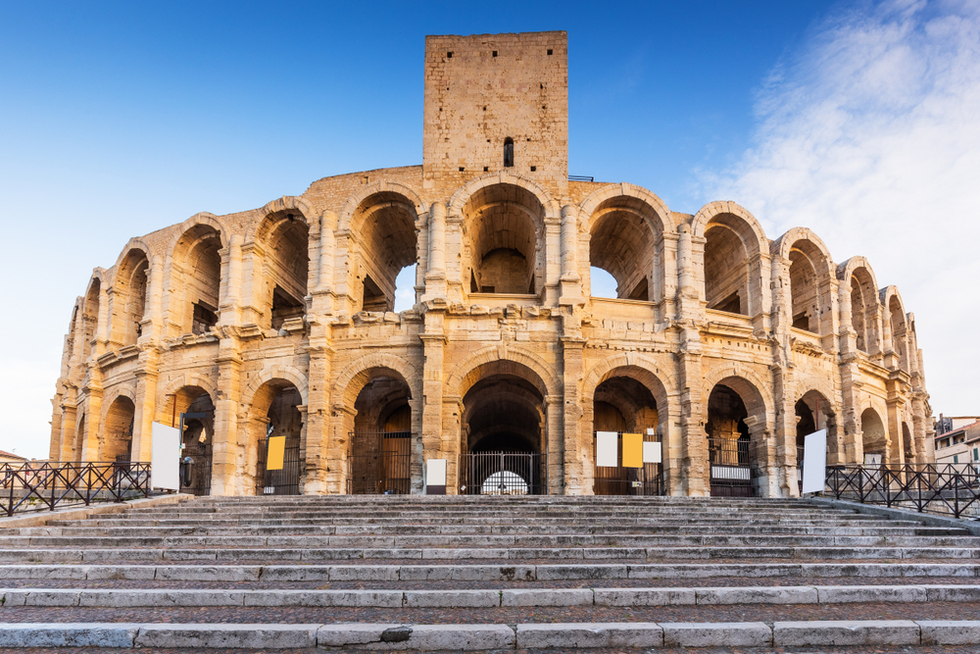The Place du Forum, shaded by plane trees, stands around the old Roman forum. The Terrasse du Café le Soir, immortalized by Van Gogh, is now the square’s Café Van Gogh. Visitors keen to follow in the footsteps of the great artist may pick up a Van Gogh walking map (1€; available at the tourist office), which takes in 10 important sites around the city, from the tourist office. (Alternatively, you can download it for free from the tourist board’s website—however this version is only available in French.) On a corner of place du Forum sits the legendary Grand Hôtel Nord-Pinus (www.nord-pinus.com): Bullfighters, artists, and A-listers have all stayed here. Three blocks south, the Place de la République is dominated by a 15m-tall (49-ft.) red granite obelisk.
One of the city’s great classical monuments is the Roman Théâtre Antique, rue du Cloître ( tel. 04-90-49-59-05). Augustus began the theater in the 1st century; only two Corinthian columns remain. The Venus of Arles (now in the Louvre in Paris) was discovered here in 1651. The theater is open May through September daily 9am to 7pm; March, April, and October until 6pm; and November through February daily 10am to 5pm. Admission is 9€ adults, 7€ students, and free children 17 and under. The same ticket admits you to the nearby Amphitheater (Les Arènes), rond-pont des Arènes (pictured above, tel. 04-90-49-59-05; same opening hours), also built in the 1st century. Sometimes called Le Cirque Romain, it seats almost 25,000. For a good view, climb the three towers that remain from medieval times, when the amphitheater was turned into a fortress.
One of Arles's zaniest family-friendly attractions is to ride a velorail along a disused railway track. These "bike-train" contraptions must be pedaled along one of two 8km routes through virgin countryside. The tracks themselves once hauled olive oil and minerals and were used by Vincent van Gogh. One route starts from Arles city center (www.veloraildesalpilles.fr; book online for 14€ adults; 7€ for children aged 5-17; free for children 4 and under).
Two potential side trips from Arles include the old Roman city of Nîmes and the marshy delta of the Camargue.
Les Taureaux
Bulls are a big part of Arlesien culture. It’s not unusual to see bull steak on local menus, and saucisson de taureau (bull sausage) is a local specialty. The first bullfight, or corrida, took place in the amphitheater in 1853. Appropriately, Arles is home to a bullfighting school (the Ecole Taurine d’Arles). Like it or loathe it, corridas are still held during the Easter Ferias and in September, during the Ferias du Riz.
Mistral, Two Ways
Born just north of Arles, Frédéric Mistral (1830–1914) dedicated his life to defending and preserving the original Provençal language known as Occitan. The poet won the Nobel Prize for his epic work “Mirèio” and his overall contributions to French literature. Mistral joined six other Provençal writers in 1854 to found Félibrige, an association for the promotion of Occitan language and literature. He is the author of “Lo Tremor dóu Félibrige,” the most comprehensive dictionary of the Occitan language to this day. Many think Mistral lent his name to the notorious glacial wind that roars through Provence every year. However, in this case, mistral is the Occitan word for “master”—and those who experience the phenomenon regularly say it’s a cruel one. Tearing through the Rhône River Valley toward the Mediterranean, the mistral reaches speeds of 100km (62 miles) per hour and can blow up to 100 days per year. Most of these occur in winter, but it is also common in the spring and, in unlucky years, can persist until early summer.
Note: This information was accurate when it was published, but can change without notice. Please be sure to confirm all rates and details directly with the companies in question before planning your trip.









